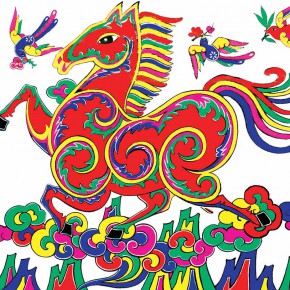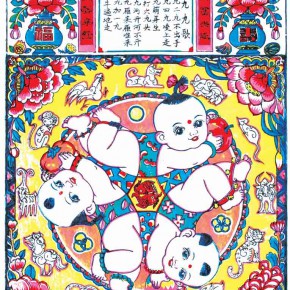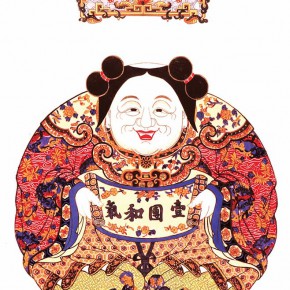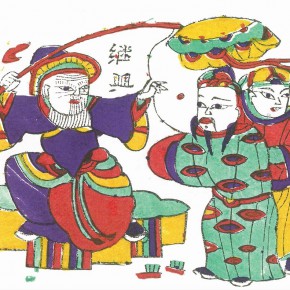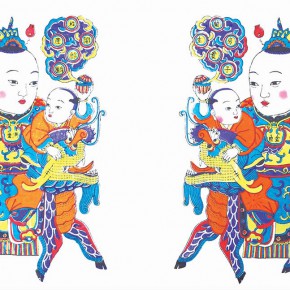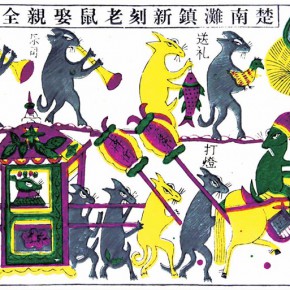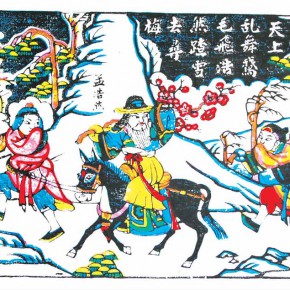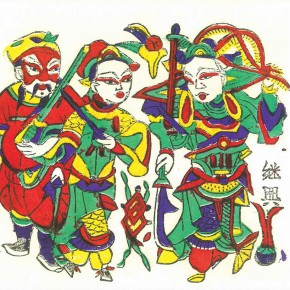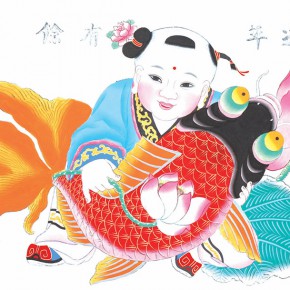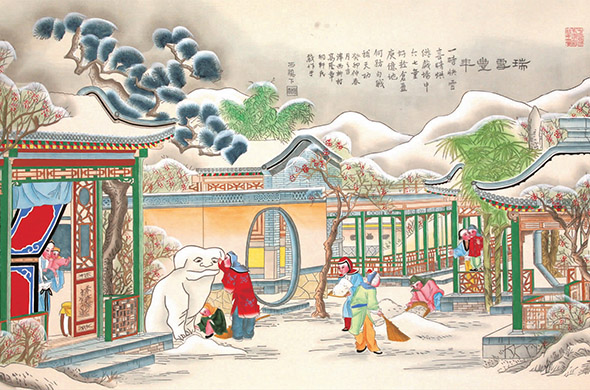
From January 1 through to February 18, 2014, “Prosperous Chinese Dream – First Chinese Woodblock New Year Pictures Exhibition” is held in Beijing Art Museum. The exhibition is jointly hosted by the cultur Alrelic Academy China and Beijing Municipal Administration of Cultural Heritage, co-organized by the Cultural Heritage Professional Copy Committee of the cultur Alrelic Academy China and Beijing Art Museum.
New Year Pictures originated from the ancient “door-god pictures”, and it has been going for one thousand years. The screens are full of simple lines, bright colours, lively and warm atmospheres, and they are in an art form which Chinese people prefer. New Year Pictures are mainly posted to decorate the home during the Lunar New Year, containing an auspicious meaning to greet the Lunar New Year. All woodblock New Year paintings across the country have their own creative styles, strongly revealing the characteristics of ethnic groups and local identity. The exhibition brings together the woodblock New Year pictures from six places including Zhuxianzhen of Henan, Yangjiabu of Shandong, Yangliuqing of Tianjin, Wuqiang of Hebei, Taohuawu of Jiangsu and Tantou of Hunan, showing the local characteristics and styles of New Year pictures.
Zhuxianzhen woodblock New Year pictures originated from the Tang Dynasty, flourishing in Song Dynasty, it was in a period of great prosperity in the Ming and Qing Dynasties, which influenced Taohuawu of Jiangsu and Yangjiabu of Shandong to a varying degree. The composition of Zhuxianzhen woodblock New Year pictures is full, with rough lines, exaggerated shapes and gorgeous colours. Most themes come from historical heroes, operas and historical novels, mythology and folklore, strongly which reflect local culture. Such as “Weishui River”, “Tianhepei, a Chinese Legend about the Love of a Cowherd and a Weaving Maid”, “Sanniang Taught Her Son”, “Fan Jiang Guan (Xue Jinlian and Fan Lihua’s Competition with Swords)”, etc.
Yangjiabu woodblock New Year pictures emerged in the Ming Dynasty, becoming prosperous in the Qing Dynasty. It covers a variety of themes and forms, satisfying the desire of the masses to remove evils and receive good luck, while it also focuses and reflects real life, some New Year pictures reflect everyday life such as “Tianjin School’s Instructor”.
Yangliuqing woodblock New Year pictures were born in the ancient town of Yangliuqing in the middle of the 17th Century. Yangliuqing woodblock New Year pictures have a featured artistic form that is the combination of woodblock chromatography and use of manual drawing colours.
Wuqiang New Year pictures emerged in the early 15th century, becoming prosperous in the 18th Century. Its composition is compact and full, quaint and plain, and the engraving lines are fat and free, solid and clear. The colour is strong, and it is good at using pure colour, showcasing a rich effect through chromatography. Secondly illustration is another characteristic of Wuqiang New Year pictures, for many pictures encompass funny humorous poetry. Such as Meng Haoran Looked for Plum Blossom”, “Six Children with Three Heads (Fight for the Lead Position)”.
Taohuawu woodblock New Year pictures of Jiangsu originated in the late Ming Dynasty and the early Qing Dynasty. The industry and commerce of the Suzhou area is prosperous and life is rich, thus local New Year pictures are rich in Jiangnan style, such as “Three Gods Figure (includes Bodhisattva Guanyin, Guan Yu and the God of Wealth)”.
Tantou woodblock New Year pictures are the only manual pictures of woodblock print in Hunan Province, creating a unique style from intense local features of the south of Chu, using gorgeous and moist colours, a plain and exaggerated shaping method, such as “A Mouse Gets Married”, “The Twelve Zodiacs –‘Immediately (Year of the Horse) Announcing Good News’”.
During the exhibition, a “Woodblock New Year Pictures DIY Activity” was unfolded for young participants in the Beijing Art Museum. The participants could manually produce a New Year picture by themselves, and participate in the competition.
Translated by Chen Peihua and edited by Sue/CAFA ART INFO.



